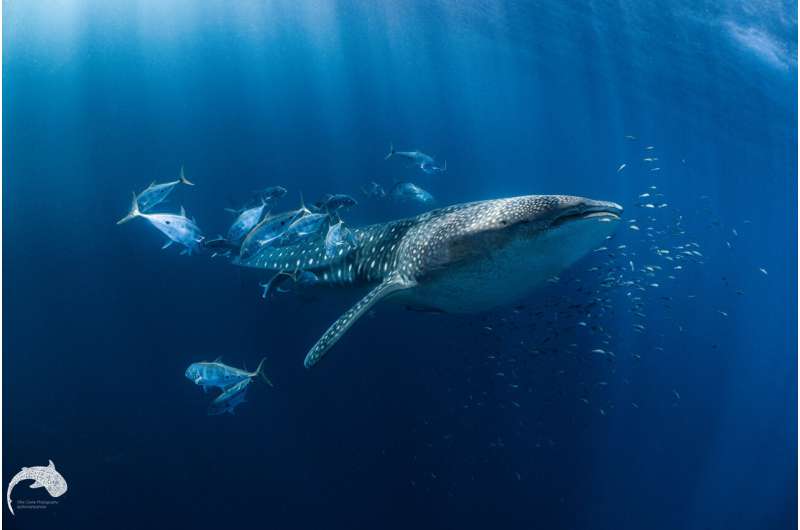This article has been reviewed according to Science X's editorial process and policies. Editors have highlighted the following attributes while ensuring the content's credibility:
fact-checked
peer-reviewed publication
trusted source
proofread
Hungry trevally devour entire schools of whale shark baitfishes

At Ningaloo Reef in Western Australia, whale sharks are frequently observed swimming through the water with thousands of small (around 10cm in length) carangid baitfishes swarming around them.
Not on the whale shark menu, it was previously thought the little fish traveled with the massive sharks for protection.
However, new research from Murdoch University's Harry Butler Institute has revealed large schools of up to 200 trevally (greater than 30cm in length) are gorging on entire schools of baitfishes in flash feeding events lasting from two to 45 seconds.
Published in Marine Biology, the findings suggest baitfishes huddle around whale sharks, the world's biggest fish reaching up to 18m in length, for reasons other than safety.
Lead author Christine Barry, who is completing a Ph.D. at HBI's Center for Sustainable Aquatic Ecosystems and the Australian Institute of Marine Science, analyzed footage from cameras attached to juvenile whale sharks (up to 7m) and an opportunistic video captured by a Ningaloo tourism photographer.
She said rather than reducing predation, the association of baitfishes with whale sharks may be due to energetic or food acquisition advantages.
"Whale sharks at Ningaloo Reef move throughout the region to locate dense patches of food," Barry said.
"By riding the bow wave, the accompanying baitfish save valuable energy by moving through the water with their whale shark taxis.
"Furthermore, despite their massive size difference, baitfish and whale sharks eat the same food—such as plankton—but the amount eaten by the baitfishes barely impacts the resources available to the sharks."
Barry said the advantages of traveling with whale sharks—movement and increased food opportunities—likely led to a commensal relationship that was energetically beneficial to the baitfishes.
"But they are still very vulnerable to predatory fishes when accompanying their giant friends, as the dramatic trevally feeding frenzy videos showed," she said.
More information: Christine Barry et al, Predation of baitfishes associated with whale sharks at Ningaloo Reef, Marine Biology (2023). DOI: 10.1007/s00227-023-04291-4
Journal information: Marine Biology
Provided by Murdoch University


















